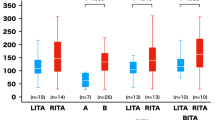Abstract
Arterial grafts such as right internal mammary artery (RIMA), radial artery (RA) or epigastric artery are being used with increasing frequency as free grafts or as composite grafts with left internal mammary artery (LIMA). Currently, there is no consideration of the orientation of the free artery graft to mimic the in vivo state. Hence, some grafts may be oriented such that the direction of blood flow exerted on the endothelium is reversed relative to the in vivo condition. Previous studies have shown that transient flow reversal lead to atherogenesis. A recent study demonstrated that nitric oxide is significantly reduced during reverse flow and the reduction is mediated through an increase in superoxide production. In light of these data, we suggest that the flow direction is important and recommend the assurance of proper orientation of the free arterial graft. Furthermore, we propose a new surgical procedure to modify the composite LIMA-RA or LIMA-RIMA configuration as a horseshoe or K composite graft to ensure proper orientation of the flow direction relative to the endothelium.




Similar content being viewed by others
REFERENCES
Abbott, W. M., J. Megerman, J. E. Hasson, G. L’Italien, and D. F. Warnock. Effect of compliance mismatch on vascular graft patency. J. Vasc. Surg. 5(2):376–382, 1987.
Agüero, O. R., J. L. Navia, J. A. Navia, and E. Mirtzouian. A new method of myocardial revascularization with the radial artery. Ann. Thorac. Surg. 67:1817–1818, 1999.
Chappell, D. C., S. E. Varner, R. M. Nerem, R. M. Medford, and R. W. Alexander. Oscillatory shear stress stimulates adhesion moledcule expression in cultured human endothelium. Circ. Res. 82:532–539, 1998.
De Keulenaer, G., D. C. Chappel, N. Ishizaka, R. M. Nerem, R. W. Alexander, and K. K. Griendling. Oscillatory and steady laminar shear stress differentially affect human endothelial redox state: role of superoxide-producting NADH oxidase. Circ. Res. 82:1094–1101, 1998
Fukai, T., R. J. Folz, U. Landmesser, and D. G. Harrison. Extracellular superoxide dismutase and cardiovascular disease. Cardiovasc. Res. 55:239–249, 2002.
Giddens, D. P., C. K. Zarins, and S. Glagov. The role of fluid mechanics in the localization and detection of atherosclerosis. J. Biomech. Eng. 115:588–594, 1993.
Kobayashi, J., O. Tagusari, K. Bando, K. Niwaya, H. Nakajima, M. Ishida, S. Fukushima, and S. Kitamura. Total arterial off-pump coronary revascularization with only internal thoracic artery and composite radial artery grafts. Heart Surg. Forum. 6(1):30–37, 2002.
Ku, D. N., D. P. Giddens, C. K. Zarins, and S. Glagov. Pulsatile flow and atherosclerosis in the human carotid bifurcation. Positive correlation between plaque location and low oscillating shear stress. Arteriosclerosis 5(3):293–302, 1985.
Li, H., and U. Forstermann. Nitric oxide in the pathogenesis of vascular disease. J. Pathol. 190:244–254, 2000.
Lu, X., and G. S. Kassab. Nitric oxide is significantly reduced in ex vivo porcine arteries during reverse flow because of increased superoxide production. J. Physiol. 561(2):575–582, 2004
Markos, F., B. A. Hennessy, M. Fitzpatrick, and J. O’Sullivan, H. M. Snow. Reverse arterial wall shear stress causes nitric oxide-dependent vasodilation in the anaesthetised dog. Pflugers. Arch. 445:51–54, 2002.
Shaaban, A. M., and A. J. Duerinckx. Wall shear stress and early atherosclerosis: a review. Am. J. Roentgenol. 174:1657–1665, 2000.
Silacci, P., K. Formentin, K. Bouzourene, F. Daniel, H. R. Brunner, and D. Hayoz. Unidirectional and oscillatory shear stressdifferentially modulate NOS III gene expression. Nitric Oxide. 4:47–56, 2000.
Sorop, O., J. A. E. Spaan, T. E. Sweeney, and E. VanBavel. Effect of steady versus oscillating flow on porcine coronary arterioles: involvement of NO and superoxide anion. Circ. Res. 92:1344–1351, 2003.
Traub, O., and B. C. Berk. Laminar shear stress: mechanisms by which endothelial cells transducer an atheroprotective force. Arterioscler. Thromb. Vasc. Bio. 18:677–685, 1998.
Zhao, S., A. Suciu, T. Ziegler, J. E. J. Moore, E. Burki, J. J. Meister, and H. R. Brunner. Synergisitic effects of fluid shear stress and cyclic circumferential stretch on vascular endothelial cell morphology and cytoskeleton. Arterioscler. Thromb. Vasc. Biol. 15:1781–1786, 1995.
Author information
Authors and Affiliations
Corresponding author
Rights and permissions
About this article
Cite this article
Kassab, G.S., Navia, J.A. & Lu, X. Proper Orientation of the Graft Artery Is Important to Ensure Physiological Flow Direction. Ann Biomed Eng 34, 953–957 (2006). https://doi.org/10.1007/s10439-006-9104-x
Received:
Accepted:
Published:
Issue Date:
DOI: https://doi.org/10.1007/s10439-006-9104-x




